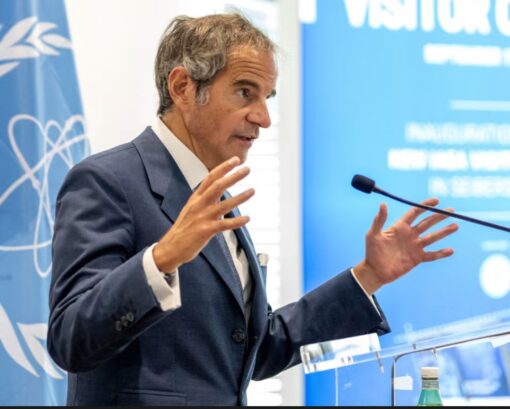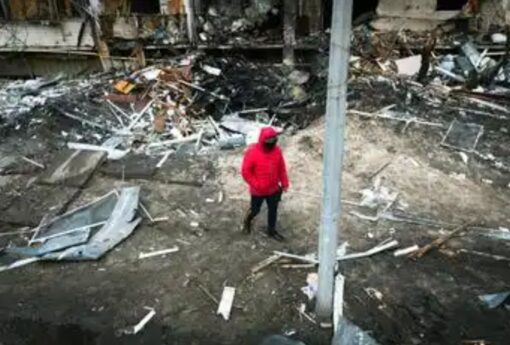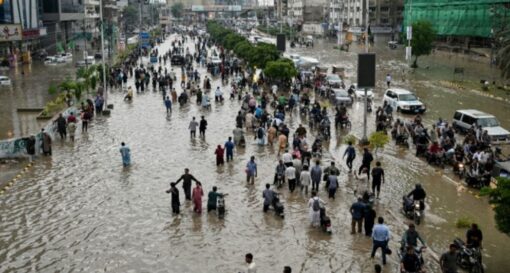A drone explosion near a Ukrainian nuclear power plant has reignited international fears of a potential disaster as the war with Russia grinds on. The detonation, which occurred within close range of the South Ukraine nuclear facility in Mykolaiv region, prompted urgent warnings from the United Nations’ nuclear watchdog about the risks posed by repeated aerial incursions near sensitive infrastructure.
The International Atomic Energy Agency confirmed that monitors on site reported more than 20 drones flying within the plant’s monitoring zone late Wednesday into Thursday morning. Some of the unmanned aircraft came as close as 500 meters from the facility’s perimeter, before one was shot down and exploded roughly 800 meters away.
The blast left a crater, damaged nearby structures, and knocked down a power line that fortunately was not connected to the reactors. Windows of parked vehicles were shattered, and metal frames showed signs of shrapnel impact.
IAEA director Rafael Grossi cautioned that although the plant itself remained unharmed, the proximity of the strike underscored the extreme vulnerability of nuclear sites during active conflict.
He stressed that while this time the damage was limited, future incidents might not be so fortunate. The warning highlighted the ongoing risks as drones and missile attacks continue to crisscross Ukrainian airspace.

The incident at South Ukraine comes amid renewed attention on the Zaporizhzhia plant, which remains under Russian occupation. That facility has now been forced to rely on emergency diesel generators after its external power supply was cut for the tenth time since the conflict began.
Without those power lines, reactors lose the vital cooling systems that prevent a catastrophic meltdown. Prolonged outages increase the danger of a nuclear accident, raising alarm far beyond Ukraine’s borders.
Concerns over nuclear safety are only one part of a wider picture of humanitarian violations documented during the war. A fresh report from the Organisation for Security and Cooperation in Europe accused Russia of systematic abuse of Ukrainian prisoners of war.
Investigators documented arbitrary killings, torture, and denial of fair trial rights, as well as unsafe detention and forced transfers. According to the report, Russia has refused to recognize captured Ukrainian soldiers as legitimate prisoners of war, instead exposing them to criminal prosecution simply for taking part in combat.
The OSCE experts said they found evidence of executions both on the battlefield and within detention facilities, adding to the growing catalogue of alleged war crimes.
As these findings circulated, Russian foreign minister Sergei Lavrov delivered a defiant speech at the United Nations, claiming that NATO and the European Union had already declared “a real war” on Moscow by arming and supporting Ukraine.
His remarks were immediately dismissed by Western diplomats, with Britain’s foreign secretary describing them as fabrications intended to mask Russia’s aggression. Lavrov notably avoided any direct mention of recent statements by US president Donald Trump, who just days earlier urged NATO allies to shoot down Russian jets entering their airspace.
Tensions between Moscow and NATO members have escalated in recent weeks with increased aerial provocations. Russian fighter jets and drones have breached or approached the airspace of Poland, Romania, and other alliance states.
Suspicious drone activity has also been reported near civilian airports in Denmark and Norway, fueling suspicions that Moscow is probing vulnerabilities. In response, the United States announced approval of a $1.23 billion arms package for Germany, including hundreds of advanced air-to-air missiles.
Washington said the sale would boost Germany’s ability to deter and counter aerial threats. German chancellor Friedrich Merz pledged that his country would take every necessary measure to safeguard its skies from Russian intrusions.
Merz also took a stronger stance on financial measures against Moscow, publicly endorsing the use of frozen Russian assets to fund Ukraine’s defense.
He called for the European Union to release up to €140 billion in blocked Russian funds in the form of an interest-free loan. Under the proposal, the assets would remain frozen until Russia agreed to pay reparations for its invasion, addressing legal concerns that have so far deterred EU members from direct confiscation.
Merz’s position represents a shift in Berlin’s approach, signaling growing determination within Europe to sustain Kyiv’s war effort despite economic and political challenges.
Meanwhile, Russia pressed its offensive against Ukraine’s power grid. Missile and drone strikes temporarily knocked out electricity to 70,000 residents of Chernihiv region in the north, with thousands more affected in the town of Nizhyn.
Local authorities reported heavy disruption, with repair crews working urgently to restore supplies. Energy facilities in central Vinnytsia were also targeted, leading to further outages and fires that forced emergency services into round-the-clock operations.
These repeated strikes are part of a broader Russian strategy to degrade Ukraine’s energy infrastructure ahead of the coming winter, mirroring attacks that left millions without heating or power last year.
While Ukraine braces for another difficult winter, President Volodymyr Zelenskyy sought to showcase the country’s resilience and innovation.
He met with executives from major US companies, including Amazon, Bank of America, and Westinghouse, to promote partnerships in the technology and energy sectors.
Zelenskyy emphasized Ukraine’s growing drone industry, noting that over 300 domestic companies are now contributing to defense and technology production. He predicted that Ukraine would soon begin exporting drone technologies, but only to trusted partners.
The initiative is part of Kyiv’s strategy to leverage technology as both a battlefield advantage and a future economic driver.
Zelenskyy also sought to address criticism of his government’s wartime decision to suspend elections indefinitely. Responding to questions from American media, he said he would step down once the war ended, declaring that his goal was to finish the conflict, not cling to power.

The president insisted that leadership transitions must happen in peacetime, not while Ukraine’s survival remained under threat. He also warned that if Moscow continued its aggression, Russian leaders themselves would become targets and should prepare for retaliation.
The intersection of nuclear danger, humanitarian violations, and mounting international involvement highlights how the conflict is deepening rather than de-escalating.
The near-miss at the South Ukraine nuclear plant underscored how easily a battlefield incident could trigger a global catastrophe. Reports of torture and extrajudicial killings of prisoners added to the mounting evidence of war crimes.
At the same time, Russia’s rhetoric at the UN and NATO’s preparations revealed that the confrontation has grown into a broader struggle involving the entire transatlantic alliance.
The war has now stretched well beyond 1,300 days, with no clear path to peace in sight. Ukraine remains dependent on Western military and financial support to hold the line, while Russia shows no sign of abandoning its campaign.
Each new drone, missile, or power cut demonstrates the grinding nature of a conflict that has devastated cities, displaced millions, and destabilized global security.
The nuclear risk adds an especially dangerous dimension, one that international monitors warn could turn the war from a regional tragedy into a worldwide disaster if luck runs out.


